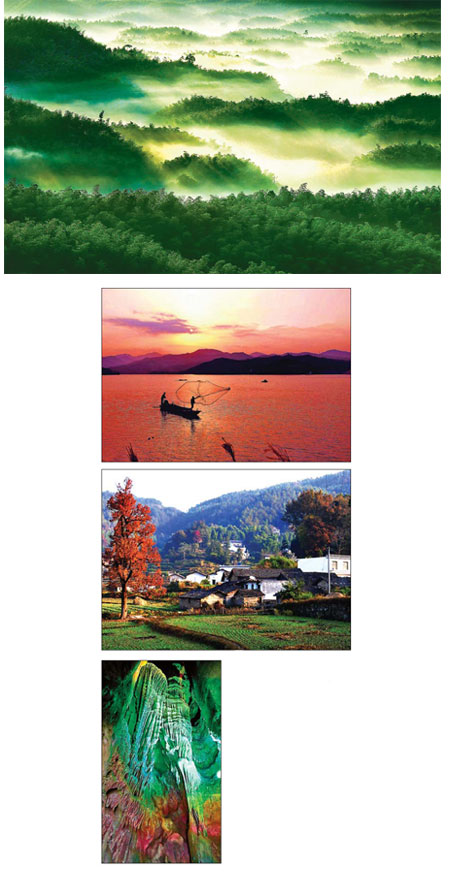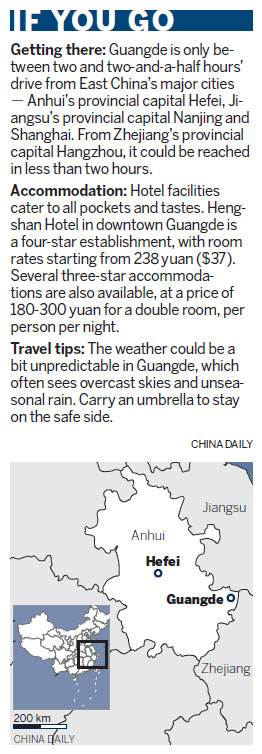Anhui adventure
Updated: 2012-06-21 09:56
By Chitralekha Basu (China Daily)
|
||||||||
 |
|
From top: Rippling hills are covered with lush bamboo forests in Anhui province's Guangde county. A fisherman casts his net to claim the last catch of the day on Luhu Lake in Guangde county. Most houses in Guangde's countryside feature white walls and dark maroon tiles. Stalactites morphed and mutated over 200 million years to create bizarre shapes in Taiji Cave. Photos Provided to China Daily |

Chinese hospitality and spooky caves that remind one of a scene out of Harry Potter are among the diverse experiences offered by Guangde county in Anhui province. Chitralekha Basu shares her discoveries.
We are driving toward Guangde from Luogang Airport in Anhui's provincial capital Hefei. Soon, the intense clusters of towering buildings under construction just outside the city's periphery are behind us. The landscape on either side of the highway - sometimes with rippling hills in the background - is lush. This is the height of summer, and the trees are bursting at the seams with foliage. The abundant greenery is punctuated by the generic double-story houses with white walls and dark maroon tiles.
Only the sky is overcast. And it drizzles, incessantly.
By the time we reach Luhu Lake, a vast manmade reservoir sprawling over a 5-square-kilometer area with a couple of islands thrown in, the landscape resembles a charcoal and gray watercolor image, still dripping color. And then the rains come pelting.
We rush inside the air-conditioned interiors of the traditional Chinese courtyard house-style Ganxi hostel, where an elaborate feast of local specialties - stuffed fathead fish and stinky tofu, among numerous others - awaits us.
This is the first in a series of overwhelmingly abundant banquets we will be treated to, twice a day, during a five-day trip to Guangde and Tianzhu, hosted by the respective tourism departments - a shining (also cautionary) example of how persuasive the Chinese can be while plying a guest with victuals and wine.
My colleague and fellow traveler on the trip, Lee Hannon, demonstrates outstanding chivalry by downing endless goblets of baijiu (white liquor) on my behalf as well as his own.
He certainly deserves an award for coping with Chinese hospitality that can smother the guest with kindness. But I digress.
Day two should be more cheerful.
The cloud cover has receded.
But we find ourselves in the spooky interiors of the Taiji Cave, an intricate network of grottoes underneath Mount Stone Dragon, where stalactites morphed and mutated over 200 million years to take on bizarre shapes.
Water drips constantly from overhead as we make our way through the slushy floors of the "dry" wing of the grottoes, stopping to admire a "thousand-petalled lotus", a "luxuriant old peepul tree", "Lord Laozi" in a top-knot and a flowing beard and a towering figure in the "Chamber of Myriad Rock Formations", which I swear could have been a streamlined version of the Statue of Liberty.
Endowed with a strong, nearly compulsive, sense of imagination, the Chinese tend to find the world that they see outside the grottoes replicated inside. So, they find menacing wolves, swimming fish and a "golden dragon coiled around a jade pillar" in precipitated mounds of limestone. Sometimes there is a whole line of holy men, sitting in a row, frozen in meditation since time immemorial.
Some of the natural phenomena appear a little creepy, though. A slow but sustained drip of water - a drop about every two seconds - for millions of years had turned a solid chunk of Mesozoic rock into a tumbler, a big scoop in its middle. Light reflected on the water accumulated inside makes the rock formation look like an unforgiving eye, the sound of the relentless drop adding to the eeriness.
Just when I begin to wonder if everything I touch is dripping wet in the "dry" wing of the cave then what the "wet" segment will be like, a boatman with a canoe appears to take us for a sail down the subterranean stream.
The tunnel, lit up in fluorescent shades of blue, green and red, looks like a scene from Harry Potter and the Goblet of Fire.
We sit stiffly, sailing the dark waters, afraid that the slightest movement, even speech, might rock the boat, even as the boatman keeps assuring us that the water isn't that deep - only 25 meters.
How he, the lone man standing, manages to duck the cave walls, often literally caving in to no higher than a meter above the water level, and maneuver the vessel through constricted passages, remains a mystery to me.
The "Chamber of Myriad Rock Formations", in fact, looks as if it was planned by an architect, if they had one in prehistoric times. It's a space where a monarch might have held court or a theater group might have performed a play - with designated places for the spectators on the floor and in the galleries, in keeping with the social hierarchy. Sediments of mica glitter from a jutting rock face overhead, offering natural lighting.
The way out can be reached by scaling a flight of 100 slippery steps, followed by a longish dark tunnel. The last segment gets a bit claustrophobic for those of us who keep procrastinating when it comes to physical exercise. The exit into sudden daylight, near the peak of the hill, is a bit too dazzling for un-shaded eyes.
The sun is so strong here that even the women at the souvenir stalls prefer to nap rather than conduct business.
The good news is that it's a downhill climb from here. Our companion Lee Hannon, of course, having put in a hard day's work, feels he has earned a cable car ride.
The sun is pouring white heat from above on day three. But the intrepid souls that we are, we show up at Lingshan falls - actually one among the nine in the bunch - in Sihe county.
A newly developed scenic area that opened to the public last October, the falls still retain unspoiled charm. The boulders through which the sparkly water flows look as if they are spit-polished every day. There is not a trace of algae anywhere.
The man in charge of its maintenance and promotion tells us these falls might well be the ideal spot to "fish in troubled waters (hun shui mo yu)". The thrill of fishing in the burbling streams under an open sky, he says, is way more exciting than doing the same in enclosed reservoirs.
That's perfectly in alignment with the spirit of the new and energetic Guangde: Try things you haven't.
Ma Chenguang contributed to this story. Contact the writer through machenguang@chinadaily.com.cn.

 'Taken 2' grabs movie box office crown
'Taken 2' grabs movie box office crown
 Rihanna's 'Diamonds' tops UK pop chart
Rihanna's 'Diamonds' tops UK pop chart
 Fans get look at vintage Rolling Stones
Fans get look at vintage Rolling Stones
 Celebrities attend Power of Women event
Celebrities attend Power of Women event
 Ang Lee breaks 'every rule' to make unlikely new Life of Pi film
Ang Lee breaks 'every rule' to make unlikely new Life of Pi film
 Rihanna almost thrown out of nightclub
Rihanna almost thrown out of nightclub
 'Dark Knight' wins weekend box office
'Dark Knight' wins weekend box office
 'Total Recall' stars gather in Beverly Hills
'Total Recall' stars gather in Beverly Hills
Most Viewed
Editor's Picks

|

|

|

|

|

|
Today's Top News
Health new priority for quake zone
Xi meets US top military officer
Japan's boats driven out of Diaoyu
China mulls online shopping legislation
Bird flu death toll rises to 22
Putin appoints new ambassador to China
Japanese ships blocked from Diaoyu Islands
Inspired by Guan, more Chinese pick up golf
US Weekly

|

|






